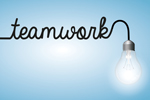How many times have you gotten a flash of insight, a great idea or remembered the name of that person you couldn't come up with, while taking a shower? The chances are likely to be more than once.
 In fact, one survey of highly creative people found that 19% of those people get their best ideas in the shower. That same survey said 13% get their best ideas while exercising and only 4% got them while brainstorming or sitting at their desk (2% each).
In fact, one survey of highly creative people found that 19% of those people get their best ideas in the shower. That same survey said 13% get their best ideas while exercising and only 4% got them while brainstorming or sitting at their desk (2% each).
What gives? Apparently it isn't just the warm soapy water, but if a shower is nearly ten times better at creating great ideas than being in a brainstorming session, we should learn more!
A bird patiently sits on her egg or eggs, providing the needed time and environment to turn embryos into chicks. This process is referred to as incubation.
Why incubation is an important part of the creative process
Incubation is part of the reason why we get those great ideas while in the shower, exercising, walking the dog, or in similar situations. And like the bird - there are two important parts to the incubation process:
Far too often we don't do either of these correctly if we want to create the best possible ideas for our teams and organisations. Since we probably won't be taking breaks from problem-solving meetings for everyone to go take a shower, we need to learn a bit more about this phenomenon and how we can use it to our advantage.
What we usually do
We are sitting in a meeting, and after identifying a problem, we are tasked with brainstorming solutions to a problem we have just clarified. To make it worse, sometimes this task comes to us in the late afternoon in a beige, cramped, nondescript conference room. And we are expected to find highly creative solutions on demand.
Is it any wonder that brainstorming tied for the bottom as a time people found their most creative ideas? To be clear, this isn’t really an indictment of brainstorming as an approach, just on how it is usually done.
How we can be better at creative success
Once we know that incubation is a key to our creative success, we can rebuild the way we work when we need new ideas - rather for ourselves or as a group. Again, time and a proper environment is necessary for incubation.
- Give people time
Taking our scenario above, what if we met to identify the problem, but then adjourned the meeting, asking people to make their list of ideas overnight, over the weekend or before the time when you will meet again? In that time, ideas will have a chance to formulate as people think about them, rather than in a command performance.
- Give people some information
Our eureka moments often happen in the shower, when exercising or other times when mildly distracted. In other words, we don't have to give too much thought to soaping and shampooing so we have time for our conscious mind to figure out what our subconscious has come up with. When we let people know how this happens and give them a clear problem to work on, we improve the odds of the great ideas. Just make sure everyone is capturing those ideas in those unexpected moments!
- Have people bring their lists
If you have given people time to incubate on the problem, ask them to come to the brainstorming session with the list they have created. Make it an expectation, maybe even set a goal of how many ideas they should bring.
- Facilitate the social environment
One reason brainstorming doesn't always produce is that people feel stifled by the judgement of others, intimidated by the rank of others or other relationship issues get in the way. As a leader, facilitate brainstorming carefully. Make it a safe place for people to share, and keep the comments about ideas away until the complete list is created. When everyone brings their personal list of ideas, we can manage some of these challenges a bit easier, and then add additional ideas that come from the group as they see the full list and make new connections.
- Improve the physical environment
You are not likely able to paint the conference room walls a brighter colour, but you might be able to pick a room with natural light, have some music playing before the session begins, bring healthy snacks or in other ways make the environment more conducive to creative thought.
Incubation - it is not just for the birds. When we take these ideas and allow others (and ourselves) to think and create the way our brains were built, we will have better success. The soap and shampoo are optional.